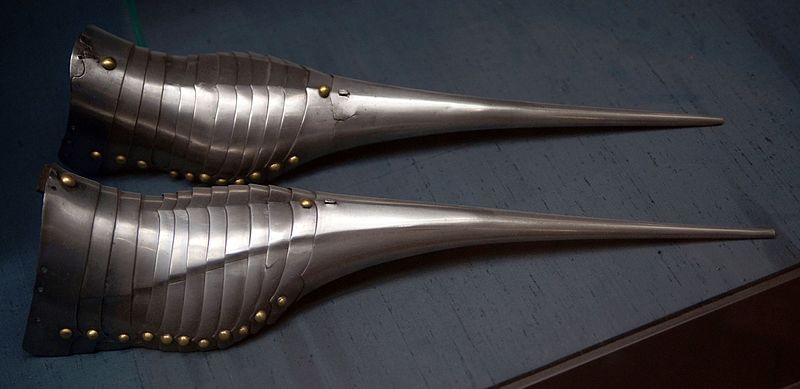A shoe or boot with an extremely elongated, pointed toe, worn in the 14th and 15th centuries.
The Details
Charlotte Mankey Calasibetta and Phyllis Tortora define poulaines in the Dictionary of Fashion” (2013) as being a:
“long-toed shoe of soft material- either a separate shoe or cut in one piece with the hose- introduced from Poland during reign of Richard II in England. During the 14th and 15th cs., toes of shoes became so long that they were stuffed and fastened by gold and silver chains to bracelets below the knees. Also called copped, piked, or peaked shoe. Der. After Cracow, Poland. Later called poulaine (pooh-lane’). Also spelled poulain, pullayne.” (169)
Rebecca Shawcross writes in Shoes: An Illustrated History (2014):
“one of the most distinctive and intriguing shoe styles of the medieval period was the poulaine, also known as the pike or Crakow. A low-cut, flat-soled, slip-on shoe- sometimes fastened with a side lace or toggle- the poulaine’s distinctive feature was its very pronounced, pointed toe.” (28)
Figure 1 is a 14th-century painting showing shoemakers at “their table of pointed-toe, side-lacing ankle shoes. The men are holding awls, used for piercing holes in the leather in order to prepare it for the thread” (28).
Figure 2 shows a poulaine from c. 1350-1400 which was:
“recovered from archaeological excavations at Baynard’s Castle on the north bank of the River Thames, London. It is thought that these shoes came from wealthy households, since few of them show any signs of repair. A number may even come from the Royal Wardrobe, which lay to the north of the excavation site.” (29)
A pair of surviving poulaines in the Museum of Fine Arts Boston’s collection illustrates well the easy slip-on nature of the shoes (Fig. 3). They reached ostentatious lengths in court circles as can be seen in the 1460-67 Marriage of Renaud of Mantauban and Clarisse (Fig. 4).
In the Berg Dictionary of Fashion History (2010) poulaines are defined under the term piked and peaked shoe, as: “shoes with long spear-like points extending beyond the toes” (157). The shoe’s pointed design was also created in metal for armor (Fig. 5). Riello and McNeil’s Shoes: A History from Sandals to Sneakers (2006) write of a legend of a “defeat inflicted by poor Swiss peasants against the mighty Hapsburg cavaliers that was partially due to wearing long pointed shoes” (68).
Vogue recounts a similar story:
“For a hundred or so years, from the late 14th century onward, a fashion persisted in Europe for a style of shoe called the krakow, with a toe so extravagantly long (called a poulaine) that it sometimes needed a whalebone or a string tied to the knee to keep it from getting in the way while its wearer was walking. At the Battle of Nicopolis in 1396, when the Ottomans routed an army of European crusaders, the French contingent was forced to cut off the tips of their poulaines in order to beat a speedy retreat.”
Fig. 1 - Arnau Bassa (Catalan, died 1348). Saint Anian of Alexandria reparing Mark's shoes, 1346. Manresa Seu (church of Saint Mary). Source: Wikimedia
Fig. 2 - Maker unknown. Shoe, late 14th century. Leather; 31 x 7 x 6.8 cm. London: Museum of London, BC72[79]<2496>. Source: Museum of London
Fig. 3 - Maker unknown (French). Pair of poulaine (or crakow ) shoes, 15th Century. Silk plain weave covered with silk velvet, silk binding tape, silk thread, metal nails, painted leather lining, and leather; 16.5 x 10.6 x 45 cm (6 1/2 x 4 3/16 x 17 11/16 in). Boston: Museum of Fine Arts, 44.572a-b. The Elizabeth Day McCormick Collection. Source: MFA
Fig. 4 - Loyset Liedet (Netherlandish, born 1420). The Marriage of Renaud of Mantauban and Clarisse, 1460-7. Paris: Bibliothèque de l'Arsenal, Ms.5073, f.117v.. Source: Wikimedia
Fig. 5 - Lorenz Helmschmied (German, 1450-1515). Armoured shoes of Maximilian I, 1485. Vienna: Kunsthistorisches Museum, A 62. Source: Wikipedia
Its Afterlife
The poulaine also has had more modern-day recreations. Rei Kawakubo showcased her entire Spring 2015 collection for Comme des Garçons with models wearing variations of the shoe (Fig. 6).
Fig. 6 - Rei Kawakubo (Japanese, 1942-). Comme des Garçons Homme Plus, Spring/Summer 2015. Source: Pinterest
References:
- Calasibetta, Charlotte Mankey, Phyllis G. Tortora, Charlotte Mankey Calasibetta, and Publications Fairchild. The Fairchild Dictionary of Fashion. 3rd ed. New York: Fairchild Publications, 2003. http://www.worldcat.org/oclc/959132362.
- “Comme Des Garçons Homme Plus Spring 2015 Menswear Fashion Show.” Vogue. Accessed August 15, 2018. https://www.vogue.com/fashion-shows/spring-2015-menswear/comme-des-garcons-homme-plus.
- Cumming, Valerie, C. Willett Cunnington, Phillis Cunnington, Charles Relly Beard, and C. Willett Cunnington. The Dictionary of Fashion History. Oxford: Berg, 2010. http://www.worldcat.org/oclc/1008259246.
- Riello, Giorgio, and Peter McNeil, eds. Shoes: A History from Sandals to Sneakers. New York: Berg, 2006. http://www.worldcat.org/oclc/981375877.
- Shawcross, Rebecca. Shoes: An Illustrated History. London: Bloomsbury, 2014. http://www.worldcat.org/oclc/890162083.
















